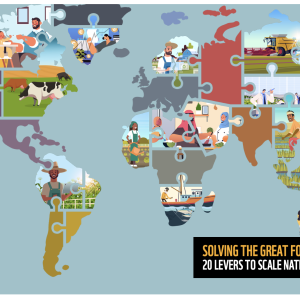
The WWF present a detailed analysis of the similarities, differences, opportunities and trade-offs across different food system types – outlining the transformation levers. It’s also an interactive tool is designed to help identify the places in which different solutions will deliver the highest impact. You can browse by country or specific solution.
Publisher’s summary
Unsustainable food systems are currently the number one threat to nature and human health, but this also creates an opportunity for food systems transformation to be the primary solution to multiple crises facing humanity. Over several years, food systems transformation has begun to be widely recognized as critical to halting and reversing nature loss, limiting global warming to 1.5 degrees Celsius and adapting to climate change, and providing all people with enough healthy and nutritious food. Despite this, there remain critical gaps in ambition, strategy and implementation, and failure to close these gaps will preclude our chances of realizing the tremendous potential of food system transformation
Although there is an urgent need to close these transformation gaps, there is no one-size-fits-all solution that can deliver impact in all countries around the world. Different regions and nations face diverse opportunities and challenges shaped by local ecology, culture and histories of development. This wide variation in local contexts, and the complexity of the global food system, creates a challenge in identifying priority actions and key levers necessary to transform food systems. To reduce this complexity, typologies can be used to help identify similarities between countries with similar contexts and actions that may have the highest impact for each Food System Type.
This is important because identifying the highest impact actions for various local contexts will help to urgently scale implementation and prevent unintended consequences. Six Food System Types (named 1-6 to avoid biases or assumptions about the food systems themselves) were identified in this study based on a set of key environmental and socioeconomic variables, with patterns emerging across the six types. For example, Type 5 food systems tend to have higher levels of environmental performance and food security than other Types but lower levels of biodiversity, whereas Type 1 systems have lower levels of environmental performance but much higher levels of biodiversity and carbon. In addition, each Food System Type tends to have one variable that performs differently, either better or worse, from other Types, which differentiates the system from others.
For instance, Type 6 systems have very high levels of self-sufficiency, Type 2 very low levels of environmental performance, and Type 4 very high levels of water risk. These variable patterns help to explain the performance of the various Food System Types, both at the country and landscape levels, and aid the identification of actions that will have the greatest impact based on local context. Given countless hyper-localized actions can be taken, we have consolidated the multitude of solutions most commonly discussed by experts and in scientific literature into 20 top-level transformation levers across six strategic action areas: Natural resource management; Governance and institutions; Education and knowledge; Technology; Trade, and Finance. We then used local expertise to assess the impact potential of each transformation lever in the different Food System Types.
Read more here. See also the TABLE explainer, What are food systems?












Post a new comment »